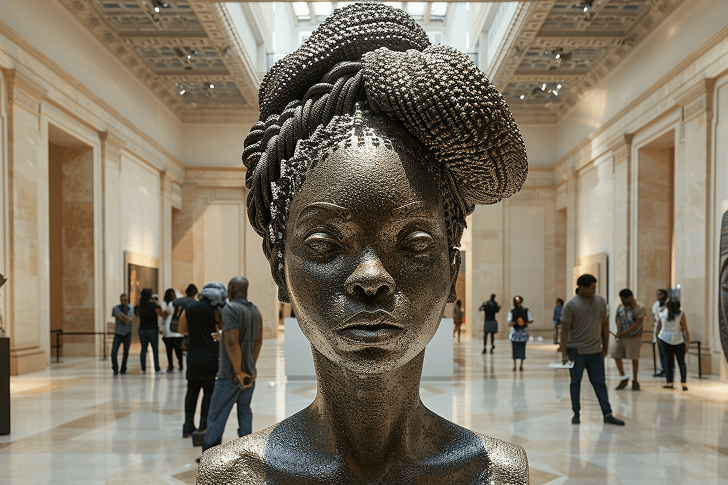In the global art conversation, Africa has long been viewed through a lens shaped by outsiders—with Western institutions often defining what African art is and how it should be interpreted. But a new wave of contemporary African artists is rewriting that narrative, combining traditional influences with modern expressions to showcase a dynamic, diverse, and deeply personal reflection of the continent.
These creators aren’t just making art. They are challenging stereotypes, shifting global perceptions, and rebuilding cultural confidence.
Reclaiming the Storyline
For decades, African artists had limited access to global platforms. Their work was often filtered through foreign galleries and collectors who prioritized exoticism over authenticity. But now, the internet and emerging platforms like ArtNativ have created a powerful shift.
Take the case of Laolu Senbanjo, a Nigerian visual artist and musician whose “Sacred Art of the Ori” has adorned everything from Beyoncé’s body in Lemonade to Nike sneakers. Laolu fuses Yoruba mythology with contemporary mediums, declaring that African spirituality and identity are not only relevant but sacred.
Similarly, Athi-Patra Ruga, a South African artist, uses performance and tapestry to critique post-colonial identity, gender, and politics, creating stunning visuals that confront and question power structures.
These artists and many others are no longer waiting for permission or validation. They are shaping their own narrative and taking up space globally.
The Blend of Tradition and Innovation
What sets modern African art apart is how it bridges the old with the new. While rooted in cultural motifs and techniques, these artworks often employ digital tools, multimedia installations, and bold political commentary.
Njideka Akunyili Crosby, a Nigerian-born, U.S.-based artist, layers photo transfers, paint, and fabric patterns to explore dual cultural identities. Her works have fetched over a million dollars at auctions and are featured in prestigious galleries worldwide. Yet, her subject matter remains deeply Nigerian—weddings, family rituals, and domestic spaces that feel familiar to anyone from West Africa.
By blending tradition with modern storytelling, these artists speak both to local audiences and the wider world, asserting that African culture is not frozen in time—it evolves.
Art as Social Commentary
African contemporary artists are also stepping into roles as activists and truth-tellers. In countries where political expression is dangerous, art becomes a powerful tool for resistance.
Chimamanda Ngozi Adichie may be best known for her writing, but her advocacy has influenced countless visual artists. Her works on feminism and African identity inspire installations, murals, and mixed media projects across the continent.
Consider Kudzanai Chiurai, a Zimbabwean artist whose work critiques post-independence corruption and state violence. His bold use of photography, collage, and performance sparks necessary dialogue, often inviting both applause and censorship.
These are not just artists. They are cultural warriors.
The Role of Platforms like ArtNativ
As more African artists emerge, so too does the need for ethical, inclusive, and empowering platforms that help them thrive. ArtNativ is not merely a marketplace—it is a mission-driven ecosystem committed to highlighting underrepresented voices and ensuring creators retain dignity and control over their work.
Through direct artist features, verified cultural context, and fair compensation structures, ArtNativ is part of the larger movement to decolonize art access and storytelling.
Bridging the Gap Between Global and Local
One of the greatest contributions of modern African artists is their ability to connect global audiences to local realities. Through vibrant storytelling, they depict everyday African life—not through the lens of poverty or war, but through celebration, resistance, love, and innovation.
Think of Aida Muluneh, the Ethiopian photographer whose vivid portraits address issues like water scarcity and female agency. Her work doesn’t pity Africa—it empowers it.
Or Osinachi, Nigeria’s leading crypto-artist, who uses Microsoft Word as his canvas and sells NFTs that challenge traditional art ownership. His global success proves that African digital art can thrive without Western gatekeeping.
Final Thoughts
Modern African artists are not just part of an art movement—they are part of a cultural renaissance. They are educating the world on what it means to be African today: multifaceted, forward-thinking, and deeply rooted.
By supporting platforms like ArtNativ, collectors and enthusiasts can become part of this revolution. Not just by buying art, but by affirming the stories and spirits behind it.
Africa is not rising. Africa has always been here.
And now, it’s speaking louder than ever.
Want to explore the works of Africa’s boldest modern creators? Join ArtNativ’s waitlist today and experience the new wave of African storytelling in art.

